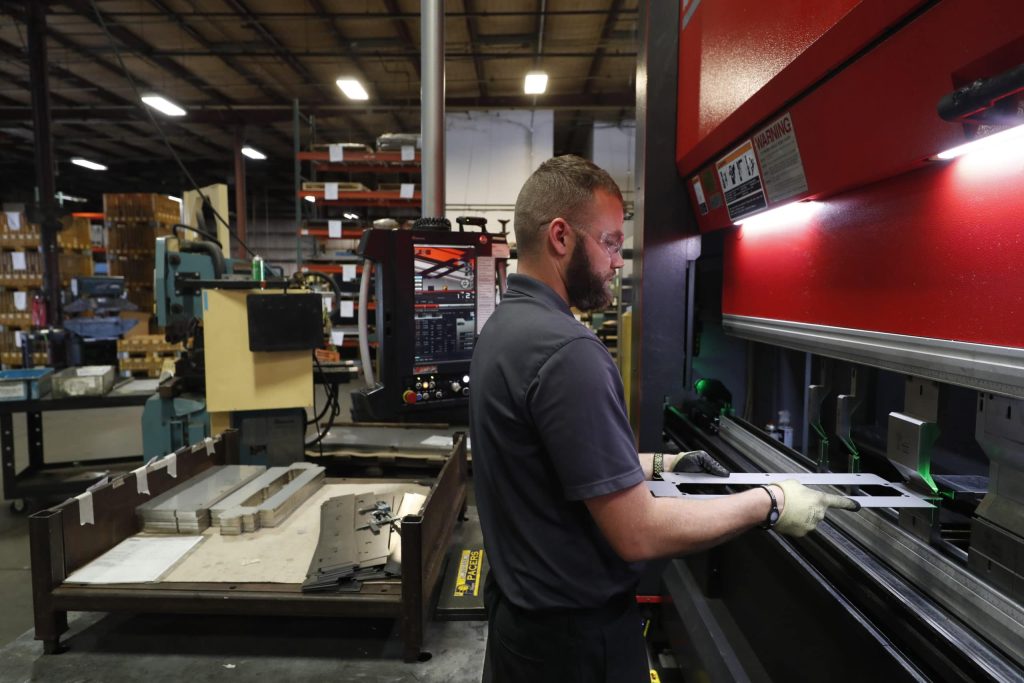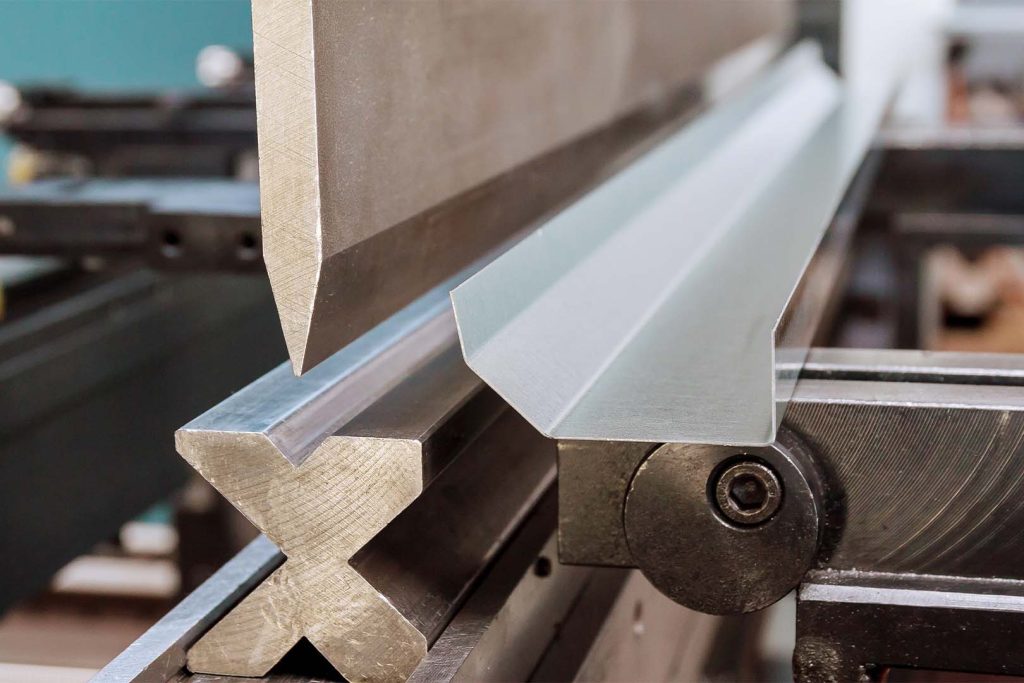Table of Contents
Are you looking to bend 16 gauge sheet metal but don’t know where to start? Look no further! In this guide, we’ll go over the steps you need to take to successfully bend your metal into the desired shape.
Whether you’re a DIY enthusiast or a professional metalworker, bending sheet metal can be a challenging task. But with the right tools and techniques, you can achieve smooth, precise bends every time. So let’s dive in and learn how to bend 16 gauge sheet metal like a pro!
To bend 16 gauge sheet metal, you will need a few tools such as a sheet metal brake and a pair of metal snips. Follow these steps:
- Mark the bend line with a marker or scribe tool.
- Secure the metal sheet in the brake and align the bend line with the clamp edge.
- Set the bending angle on the brake and bend the metal slowly.
- Release the clamp and check the bend angle.
- Trim the excess metal with metal snips as needed.
How to Bend 16 Gauge Sheet Metal?
In metal fabrication, bending sheet metal is a common and important process. Sheet metal comes in various thicknesses, and 16 gauge sheet metal is considered medium to heavy-duty. Bending 16 gauge sheet metal requires the right tools, techniques, and safety measures to achieve accurate and clean bends. In this article, we will discuss the steps to bend 16 gauge sheet metal.
Step 1: Gather the Required Tools and Materials
Before you start bending 16 gauge sheet metal, you need to gather the necessary tools and materials. The tools required for bending sheet metal include a brake press, a straight edge, a marker or a scribe, a pair of gloves, and safety glasses. You also need to have the sheet metal you want to bend, which should be cut to the desired length and width.
To bend the sheet metal accurately, you need to have a brake press. It is a machine that has a flat bed and a clamping bar that holds the sheet metal in place. The clamping bar moves up and down, and this creates the bend in the sheet metal.
Step 2: Measure and Mark the Sheet Metal
The next step is to measure and mark the sheet metal. Use a straight edge to draw a line where you want the bend to be. You can use a marker or a scribe to make the line visible. Ensure that the line is straight and accurate to get the desired bend.
Step 3: Set Up the Brake Press
After marking the sheet metal, it’s time to set up the brake press. First, adjust the clamping bar to the thickness of the sheet metal. Then, set the bending angle on the brake press to the desired degree. The angle is usually determined by the project requirements.
Step 4: Bend the Sheet Metal
Now that the brake press is set up, it’s time to bend the sheet metal. Place the sheet metal on the brake press bed, aligning the marked line with the clamping bar. Make sure that the sheet metal is firmly held in place by the clamping bar. Then, slowly lower the clamping bar to create the bend in the sheet metal. Repeat the process until you get the desired bend.
Step 5: Remove the Sheet Metal from the Brake Press
After bending the sheet metal, you need to remove it from the brake press. Use a pair of gloves to handle the sheet metal to avoid injuries. Also, ensure that the sheet metal is cooled down before handling it.
Benefits of Bending 16 Gauge Sheet Metal
Bending 16 gauge sheet metal has several benefits. For instance, it can be used to make various products such as HVAC ducts, electrical enclosures, and automotive parts. Bending sheet metal also allows you to create clean and accurate bends that enhance the aesthetic appeal of the finished product.
Bending 16 Gauge Sheet Metal Vs. Other Gauges
Compared to other gauges, bending 16 gauge sheet metal requires more force and pressure. However, it also provides more durability and strength. When bending thinner gauges, you need to be extra careful not to overbend them, as they are prone to cracking and warping. On the other hand, bending thicker gauges requires more force and may require a heavier-duty brake press.
Safety Measures When Bending 16 Gauge Sheet Metal
Bending 16 gauge sheet metal can be dangerous if proper safety measures are not taken. Always wear safety glasses and gloves when handling sheet metal. Additionally, ensure that the brake press is well-maintained, and all safety guards are in place. Never exceed the weight capacity of the brake press, and always follow the manufacturer’s instructions when operating it.
Conclusion
Bending 16 gauge sheet metal requires the right tools, techniques, and safety measures to achieve accurate and clean bends. With the steps outlined in this article, you can bend sheet metal like a pro. Remember to follow safety guidelines when handling sheet metal to avoid injuries.
Frequently Asked Questions
Here are some commonly asked questions about how to bend 16 gauge sheet metal.
What tools do I need to bend 16 gauge sheet metal?
To bend 16 gauge sheet metal, you will need a few essential tools. The first tool you will need is a sheet metal brake. This tool is used to create a straight and precise bend in the metal. You will also need a pair of metal cutting shears to cut the sheet metal to your desired size. Additionally, you will need a metal file to smooth out any jagged edges on the metal.
It is also recommended that you wear safety gloves and eye protection while working with sheet metal to prevent any injuries.
How do I prepare the sheet metal for bending?
Before you begin bending the sheet metal, you must first prepare it. Start by measuring and marking the sheet metal where you want to make the bend. Next, use the metal cutting shears to cut the sheet metal to your desired size. Once the metal is cut, use the metal file to smooth out any jagged edges.
After the sheet metal is cut and filed, you can then begin to make the bend using the sheet metal brake. It is important to follow the manufacturer’s instructions for the sheet metal brake to ensure a precise and accurate bend.
How do I make a precise bend in the sheet metal?
To make a precise bend in the sheet metal, you must use the sheet metal brake correctly. First, adjust the sheet metal brake to the desired angle and position the sheet metal in the brake. Next, use the clamping mechanism to secure the metal in place.
Finally, use the bending handle to slowly bend the metal to the desired angle. It is important to make small adjustments and check the angle often to ensure a precise bend.
Can 16 gauge sheet metal be bent by hand?
While it is possible to bend 16 gauge sheet metal by hand, it is not recommended. Hand-bending sheet metal can result in uneven and imprecise bends, which can compromise the integrity of the metal. Additionally, hand-bending can be more physically demanding and time-consuming than using a sheet metal brake.
To ensure a precise and accurate bend, it is recommended that you use a sheet metal brake to bend 16 gauge sheet metal.
What are some common mistakes to avoid when bending sheet metal?
One common mistake to avoid when bending sheet metal is applying too much pressure or force. This can cause the metal to warp or crack, compromising the integrity of the material. Another mistake to avoid is over-bending the metal, which can result in a bend that is too sharp or uneven.
It is also important to use the correct tools and follow the manufacturer’s instructions for the sheet metal brake to ensure a precise and accurate bend. Finally, be sure to wear safety gloves and eye protection to prevent any injuries while working with sheet metal.
In conclusion, bending 16 gauge sheet metal can be a challenging task, but with the right tools and techniques, it can be done successfully.
The first step is to make sure you have the right tools for the job. This includes a sturdy work table, a sheet metal brake or bending tool, and safety equipment such as gloves and eye protection.
Next, it’s important to properly measure and mark the sheet metal before attempting to bend it. This will ensure that your bends are accurate and precise.
Finally, take your time when bending the sheet metal and make small adjustments as needed. With patience and practice, you can achieve professional-looking bends in your sheet metal projects.
Overall, bending 16 gauge sheet metal requires a combination of skill, patience, and the right tools. With these tips, you can successfully bend sheet metal and create beautiful and functional projects.
Request a quote today!
[contact-form-7 id="1578" title="Contact form"]
Please compress the file into a ZIP or RAR file before uploading. Alternatively, send through your RFQ by email.
enquires@unitymanufacture.com




